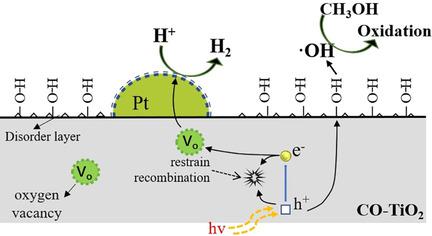当前位置:
X-MOL 学术
›
ChemSusChem
›
论文详情
Our official English website, www.x-mol.net, welcomes your
feedback! (Note: you will need to create a separate account there.)
Revealing the Relationship between Photocatalytic Properties and Structure Characteristics of TiO2 Reduced by Hydrogen and Carbon Monoxide Treatment
ChemSusChem ( IF 7.5 ) Pub Date : 2018-07-12 , DOI: 10.1002/cssc.201800940 Yunpeng Liu 1, 2 , Yuhang Li 2 , Siyuan Yang 3 , Yuan Lin 2 , Jiangliang Zuo 1 , Hong Liang 1 , Feng Peng 1
ChemSusChem ( IF 7.5 ) Pub Date : 2018-07-12 , DOI: 10.1002/cssc.201800940 Yunpeng Liu 1, 2 , Yuhang Li 2 , Siyuan Yang 3 , Yuan Lin 2 , Jiangliang Zuo 1 , Hong Liang 1 , Feng Peng 1
Affiliation

|
Reduction is considered to be an effective method to improve the photocatalytic activity of TiO2; however, the underlying relationship between structure and photocatalytic performance has not been adequately unveiled to date. To obtain insights into the effect of structure on photocatalytic activity, two types of reduced TiO2 were prepared from CO (CO‐TiO2) and H2 (H‐TiO2). For H‐TiO2, Ti−H bonds and oxygen vacancies are formed on the surface of H‐TiO2, which results in a more disordered surface lattice. However, for CO‐TiO2, more Ti−OH bonds are formed on the surface and more bulk oxygen vacancies are introduced; the disorder layer of CO‐TiO2 is relatively thin, owing to most surface vacancies being filled by Ti−OH bonds. Under simulated solar irradiation, the photocatalytic H2 evolution rate of CO‐TiO2 reaches 7.17 mmol g−1 h−1, which is 4.14 and 1.50 times those of TiO2 and H‐TiO2, respectively. The photocatalytic degradation rate constant of methyl orange on CO‐TiO2 is 2.45 and 6.39 times those on H‐TiO2 and TiO2. The superior photocatalytic activity of CO‐TiO2 is attributed to the effective separation and transfer of photogenerated electron–hole pairs, due to the synergistic effects of oxygen vacancies and surface Ti−OH bonds. This study reveals the relationship between the photocatalytic properties and structure, and provides a new method to prepare highly active TiO2 for H2 production and environmental treatment.
中文翻译:

揭示氢气和一氧化碳处理后的TiO2的光催化性能与结构特征之间的关系
还原被认为是提高TiO 2光催化活性的有效方法; 然而,迄今为止,结构与光催化性能之间的潜在关系尚未充分揭示。为了深入了解结构对光催化活性的影响,从CO(CO-TiO 2)和H 2(H-TiO 2)制备了两种类型的还原TiO 2。对于H-的TiO 2时,形成H-TiO 2的表面上的Ti-H键和氧空位2,这导致更无序表面晶格。但是,对于CO-TiO 2,在表面上形成了更多的Ti-OH键,并引入了更多的本体氧空位;由于大多数表面空位被Ti-OH键填充,因此CO-TiO 2的无序层相对较薄。在模拟太阳辐射下,CO-TiO 2的光催化H 2析出速率达到7.17 mmol g -1 h -1,分别是TiO 2和H-TiO 2的4.14和1.50倍。甲基橙在CO-TiO 2上的光催化降解速率常数是H-TiO 2和TiO 2上的2.45和6.39倍。CO-TiO 2的优异光催化活性归因于氧空位和表面Ti-OH键的协同作用,光生电子-空穴对的有效分离和转移。这项研究揭示了光催化性能与结构之间的关系,并为制备用于H 2生产和环境处理的高活性TiO 2提供了一种新方法。
更新日期:2018-07-12
中文翻译:

揭示氢气和一氧化碳处理后的TiO2的光催化性能与结构特征之间的关系
还原被认为是提高TiO 2光催化活性的有效方法; 然而,迄今为止,结构与光催化性能之间的潜在关系尚未充分揭示。为了深入了解结构对光催化活性的影响,从CO(CO-TiO 2)和H 2(H-TiO 2)制备了两种类型的还原TiO 2。对于H-的TiO 2时,形成H-TiO 2的表面上的Ti-H键和氧空位2,这导致更无序表面晶格。但是,对于CO-TiO 2,在表面上形成了更多的Ti-OH键,并引入了更多的本体氧空位;由于大多数表面空位被Ti-OH键填充,因此CO-TiO 2的无序层相对较薄。在模拟太阳辐射下,CO-TiO 2的光催化H 2析出速率达到7.17 mmol g -1 h -1,分别是TiO 2和H-TiO 2的4.14和1.50倍。甲基橙在CO-TiO 2上的光催化降解速率常数是H-TiO 2和TiO 2上的2.45和6.39倍。CO-TiO 2的优异光催化活性归因于氧空位和表面Ti-OH键的协同作用,光生电子-空穴对的有效分离和转移。这项研究揭示了光催化性能与结构之间的关系,并为制备用于H 2生产和环境处理的高活性TiO 2提供了一种新方法。









































 京公网安备 11010802027423号
京公网安备 11010802027423号